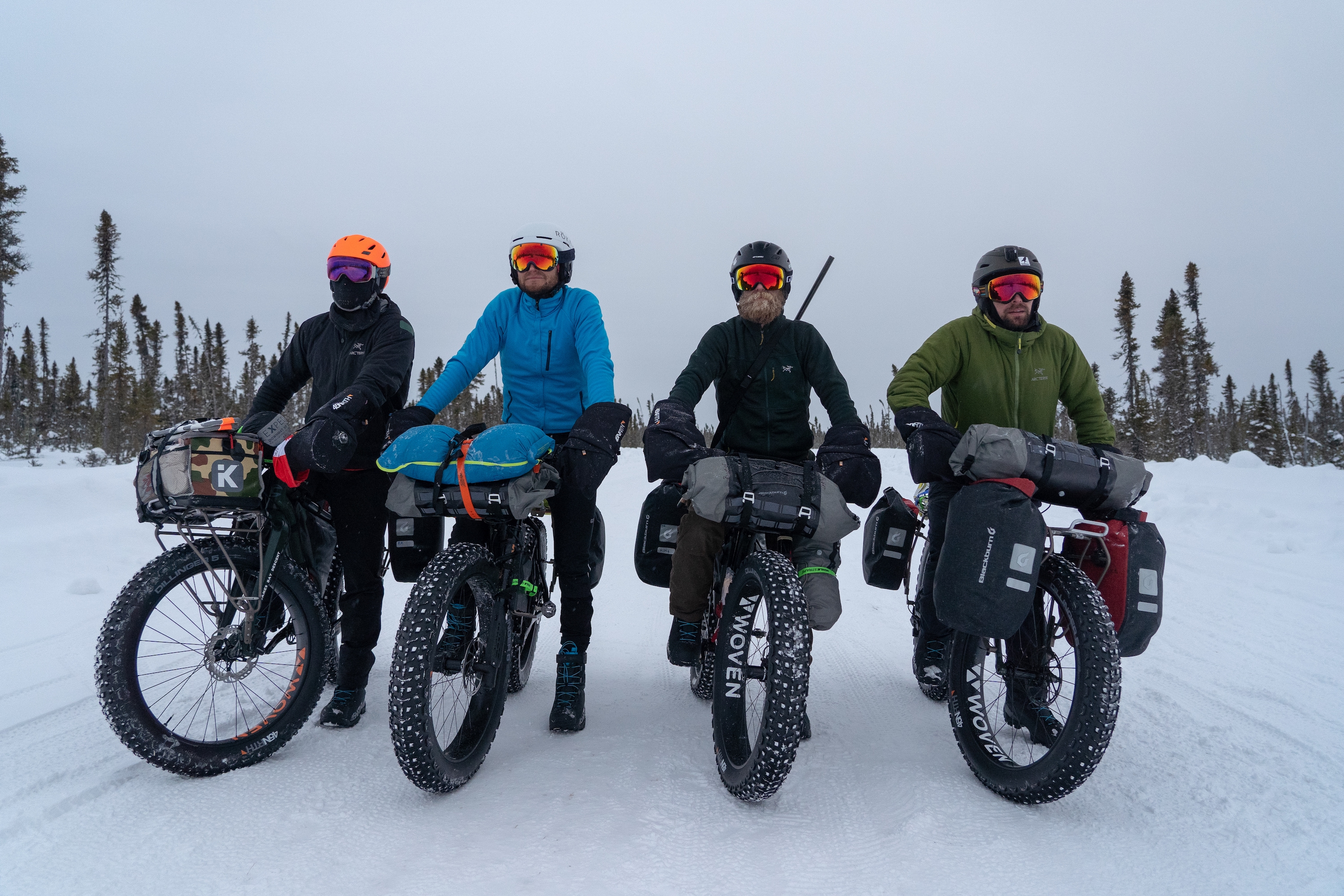In early February, as temperatures in northern Canada hovered between -20 degrees Fahrenheit and -40 degrees Fahrenheit, four retired pro-cyclists made a first-ever, self-supported fat-tire bike traverse along the shores of James Bay, Ontario. Situated on the world’s third largest muskeagh, or bog, the region is roadless and unreachable by land 10 to 11 months out of the year. But for a few short weeks in winter, when the ground sets up and the sea freezes, an ice road is forged that allows passage, wind and snow permitting. “On the most basic level,” says Ted King, one of the four riders, “it was about using bicycles to experience a place that probably no one else has [ridden a bicycle] before.”
Though adventurers were experimenting with fat-tire bikes in the late ‘80s and ‘90s and Surly Bikes launched the first commercially available model, the Pugsley, in 2005, it’s only recently that they have gained widespread acceptance and distribution. Over the last five or so years, resorts nationwide have begun to groom riding trails alongside Nordic areas, and towns such as Crested Butte, Colorado, and Marquette, Michigan, have started building an industry around them. But the bikes, which have become as diversified as the entire mountain bike market, with rigid, hardtail and full-suspension models, as well as multiple wheel sizes and tires ranging from 3.8 inches all the way up to 5.5, are also inspiring and allowing new adventures. By adding flotation and traction, the wide tires make it possible to pedal on mixed surfaces otherwise impassable by bike, including snow, ice, sand, loose rock and open country.
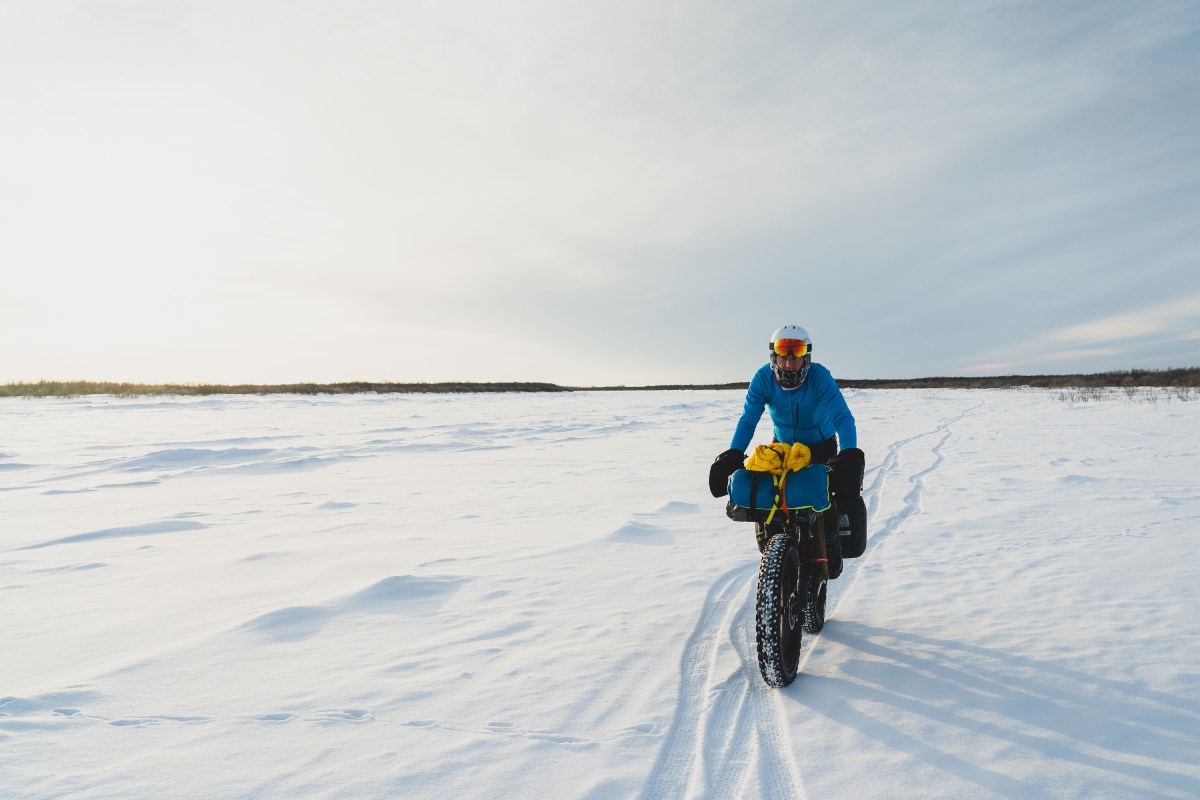
With a bit of help from a tailwind, riding a fat-tire bike in northern Canada was ‘outrageously fast,’ says Ted King. (Photo Credit: Eric Batty)
In recent years, fat-tire bikes have been used to cross everything from the route of the thousand-mile Iditarod Trail Invitational in Alaska to Antarctica. “There are many levels of wanderlust that will never be sated by riding where others ride,” says Mike Curiak, a fat-bike bike pioneer and proponent. Riding an early fat-tire bike prototype, Curiak set a course record on Alaska’s Iditarod Trail from Knik to Nome in 2000, and in 2010 became the first person to ride the course self-supported in winter. More recently, the Grand Junction, Colorado-based bike wheel-builder has been using the balloon tires to venture into the untracked desert Southwest and uncharted Alaska. “On fat bikes, you can travel in the wildest country on the planet without need for resupply.”
That’s exactly what inspired King and his crew’s Canada expedition. Dubbed the James Bay Descent, the trip was the brainchild of Kevin “Buck” Miller, a friend and once pro road race competitor of King’s who is from this region of Ontario. After Miller retired from cycling in 2008, he moved back to Moosonee, a town of 1,700 at the foot of James Bay, where he took up carpentry and settled into rural life in the north. “I still wanted to ride, and I commuted everywhere on an old crappy 26-inch mountain bike. But that bike wasn’t really up to much, and anyway there’s only a couple miles of road, and they all dead end in the swamp,” says Miller. A few times, while driving north in winter on the blare ice, he thought to himself, “This is where I should be riding.”
Fast-forward to last year, when Miller purchased a fat-tire bike. “At first, I was like, ‘Meh!’ It was so slow compared to what I was used to,” Miller says. He kept at it, though, tweaking tire pressures and experimenting with how to carry gear. “Once I got it dialed in, I realized that these bikes are just incredible,” he says. “They can go anywhere.” At last, Miller had the tool to make his expedition happen.
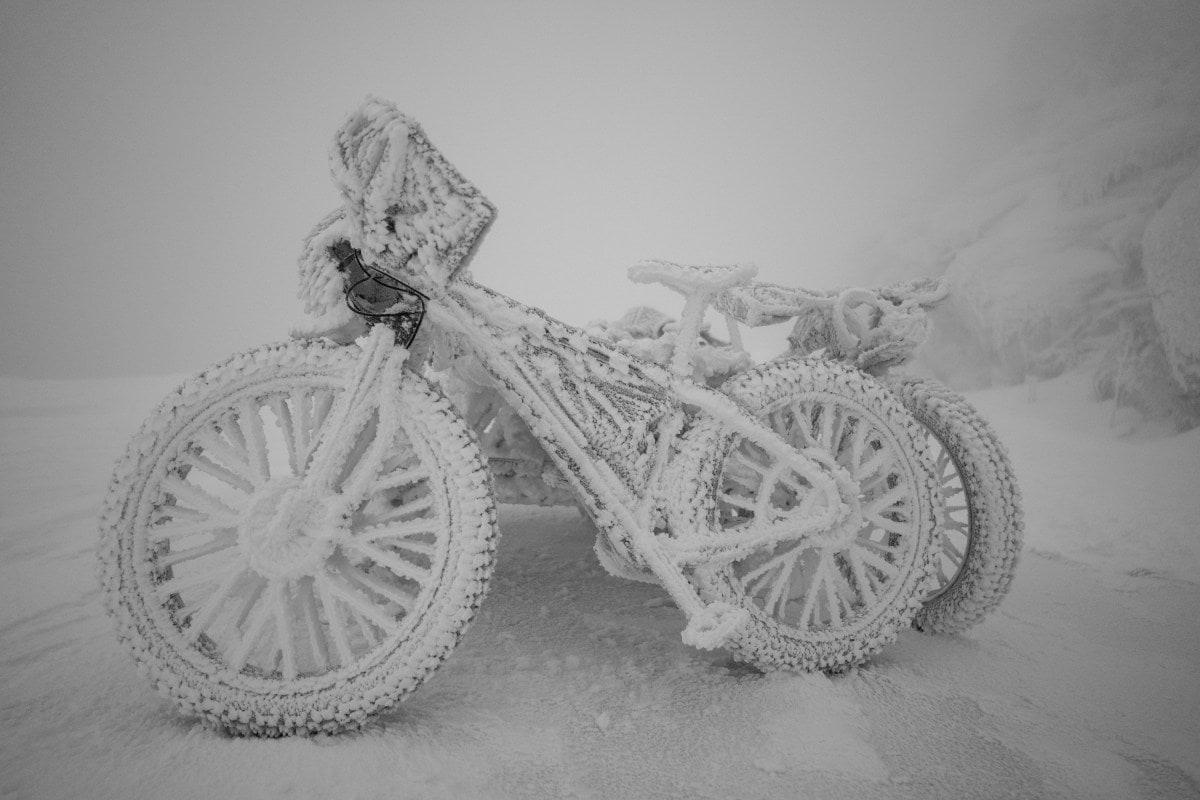
(Photo Credit: Eric Batty)
The route would link Attawispikat, a remote First Nation community midway up the coast of Hudson Bay’s southernmost inlet, with Smooth Rock Falls, the nearest road access some 250 miles south as the crow flies. The ride would begin with an open-ice crossing to Akimiski Island, part of Canada’s northernmost territory of Nunavat, before turning south and connecting a constellation of tiny, isolated villages: Kashechewan, Fort Albany, Moosonee and Moose Factory. Not only would the route mean enduring brutally cold weather, it would also take the team through polar bear country. In light of Miller’s work with Diabetes Canada, which he says has made him acutely aware of the epidemic of the disease and the need for education in the region, the group planned talks at local schools along the way where they could show off their fat-tire bikes and hopefully dialogue with the children about exercise and a healthy lifestyle. They also raised funds for the Timmins Native Friendship Center, a nonprofit in Moosonee that provides social services to people in the region. On presentation of the funds, the team was told that the funds would be used directly in the community for groceries for families, new computers, beds, and other programming needs that arise.
The team, which included two of Miller’s friends from previous backcountry escapades, former pro mountain bike racer Ryan Atkins, and retired Canadian National MTB Team member Eric Batty, set out from Attawispikat on February 5. Loaded down with apparel and gear for the frigid conditions, a four-man tent, a titanium wood stove and enough food for two weeks, their bikes, Cannondale Fat CAAds, each weighed more than 100 pounds. “We have to be honest, we never envisioned anyone riding the Fat CAAD in such a ridiculously epic adventure,” says Peter Vallance, director of product management at Cannondale. “That said, it certainly proved its capability.”
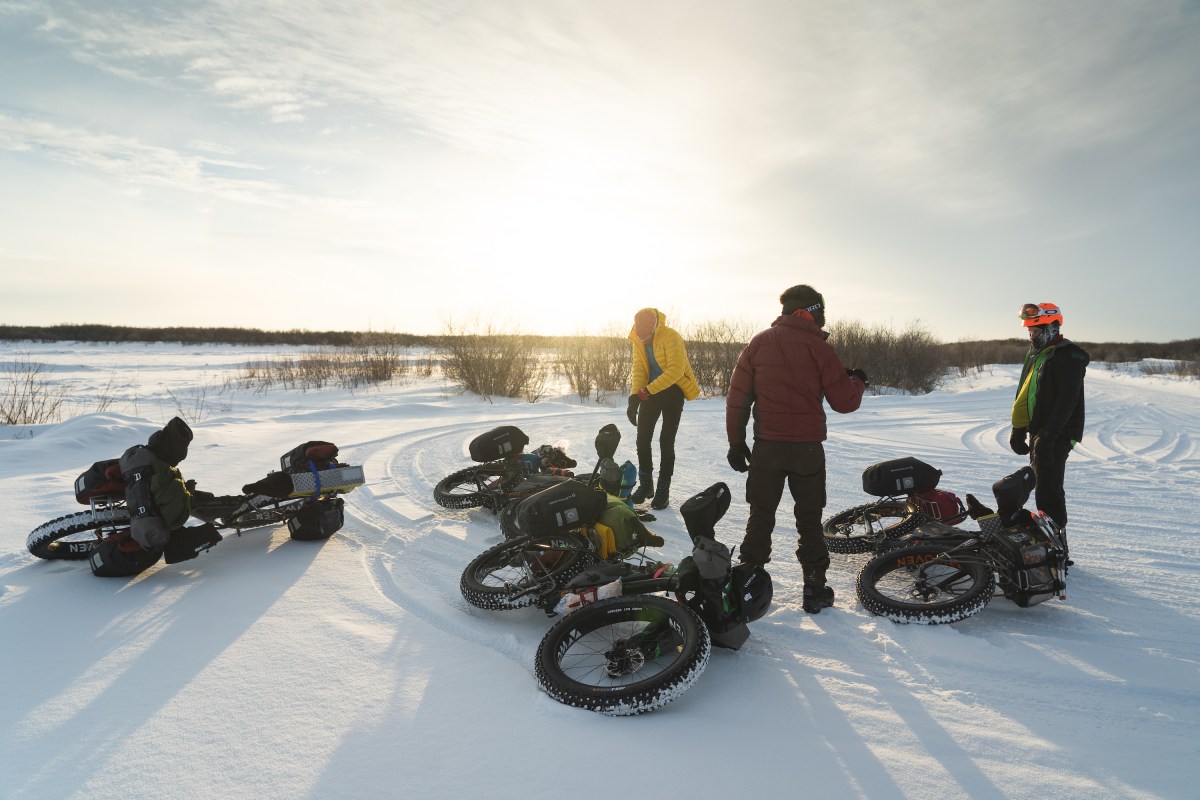
(Photo Credit: Eric Batty)
On the crossing to Akimiski Island, the group immediately encountered a problem. Despite a very cold winter, the sea ice had not fully frozen. Rather than risk plunging into open water, they scrapped the island visit and instead headed south along the coast. Conditions for the first few days were dry and very cold on surfaces that could have doubled as a skating rink. With heavy side- and tailwinds, the team blasted along in echelon formation, sometimes averaging 15 miles per hour. “It was outrageously fast on such big, heavy bikes,” says King. “It was a bit hair-raising.” At such a clip, though, it looked like the expedition would be finished a lot quicker than expected.
But at Moosonee, the halfway point, a storm struck, and between 16 inches of fresh snow and 30 to 45 mile per hour winds, the southward push ground to a halt. The day of the blizzard, the cyclists traveled only three miles, though they were able to speak at one of the local schools, where the kids grilled them with questions about their gear, their bikes, and how they were managing to subsist. “The kids were so inquisitive,” says King. “They asked all questions imaginable, but mostly it came down to, ‘Why on earth would anyone do this?’” There were so many questions, that the teachers eventually had to cut off the show.
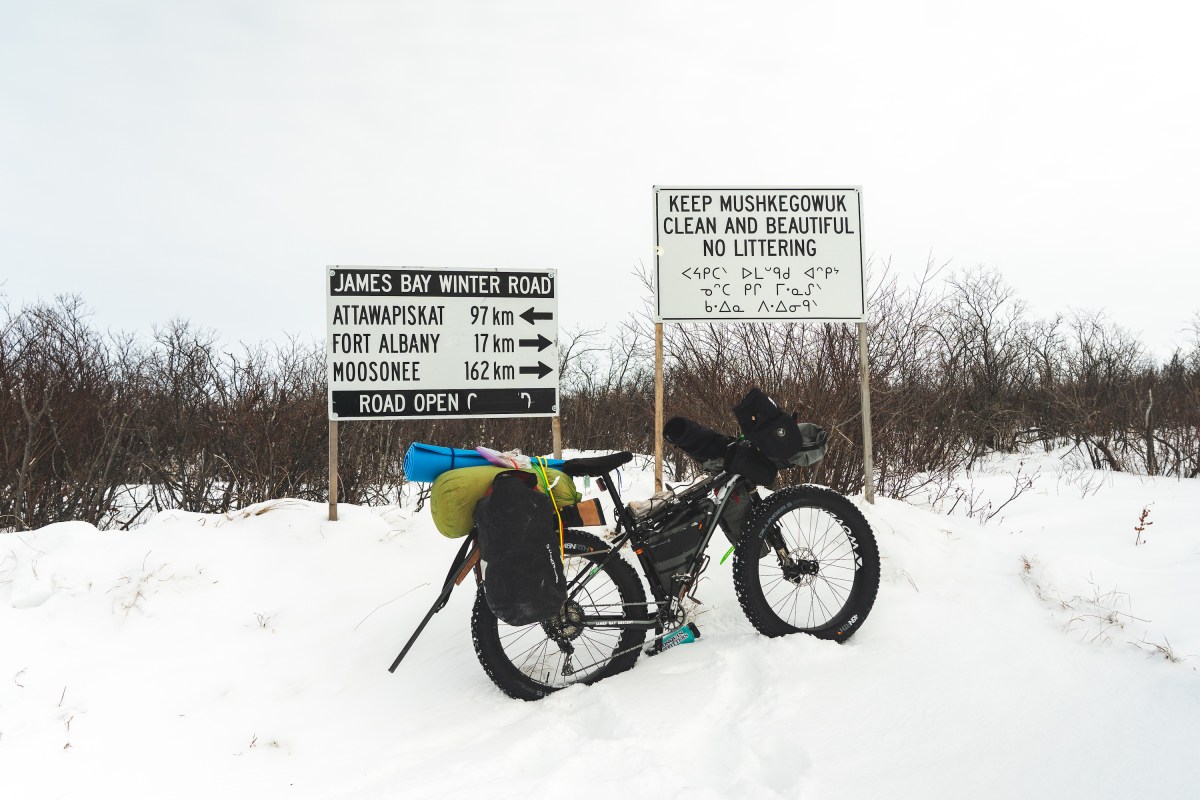
(Photo Credit: Eric Batty)
When the storm lifted, the James Bay Ice Road was closed to traffic. Unable to muscle their hulking bikes through such deep snow, Miller and company were forced to follow the snowplow and grater that was tasked with laboriously opening the road. Unlike at the beginning, when they had covered 60 to 80 miles per day, they now plodded along at half that rate. “It’s not like it’s smooth asphalt. It’s just mud and cranberry shrubs under the snow and ice, so even after the road crew did its work, the road was still soft and uneven,” says Miller. “It was brutal.”
After 100 miles of slow going, the cyclists reached a gravel forest access road that had been gated. As daytime temperatures warmed to a trip high of -18 degrees Fahrenheit and the risk of grappling with polar bears diminished because of the more southerly locale, the group was able to pick up the pace. On day 10, they pedaled into Smooth Rock Falls and were greeted with jubilee by the mayor and a group of locals who had been following their progress. “People all along the course were so gracious and interested about what we were doing,” says Miller. “We were such a curiosity because few people up there had ever seen bikes like ours, and nobody had ever conceived you could ride them in conditions like that.”
Miller says he, too, was blown away by how the bikes made the trip possible. “You couldn’t have done it on any other sort of bikes,” he says. “It’s incredible how fat bikes are opening up completely new places and terrain to riding.”
